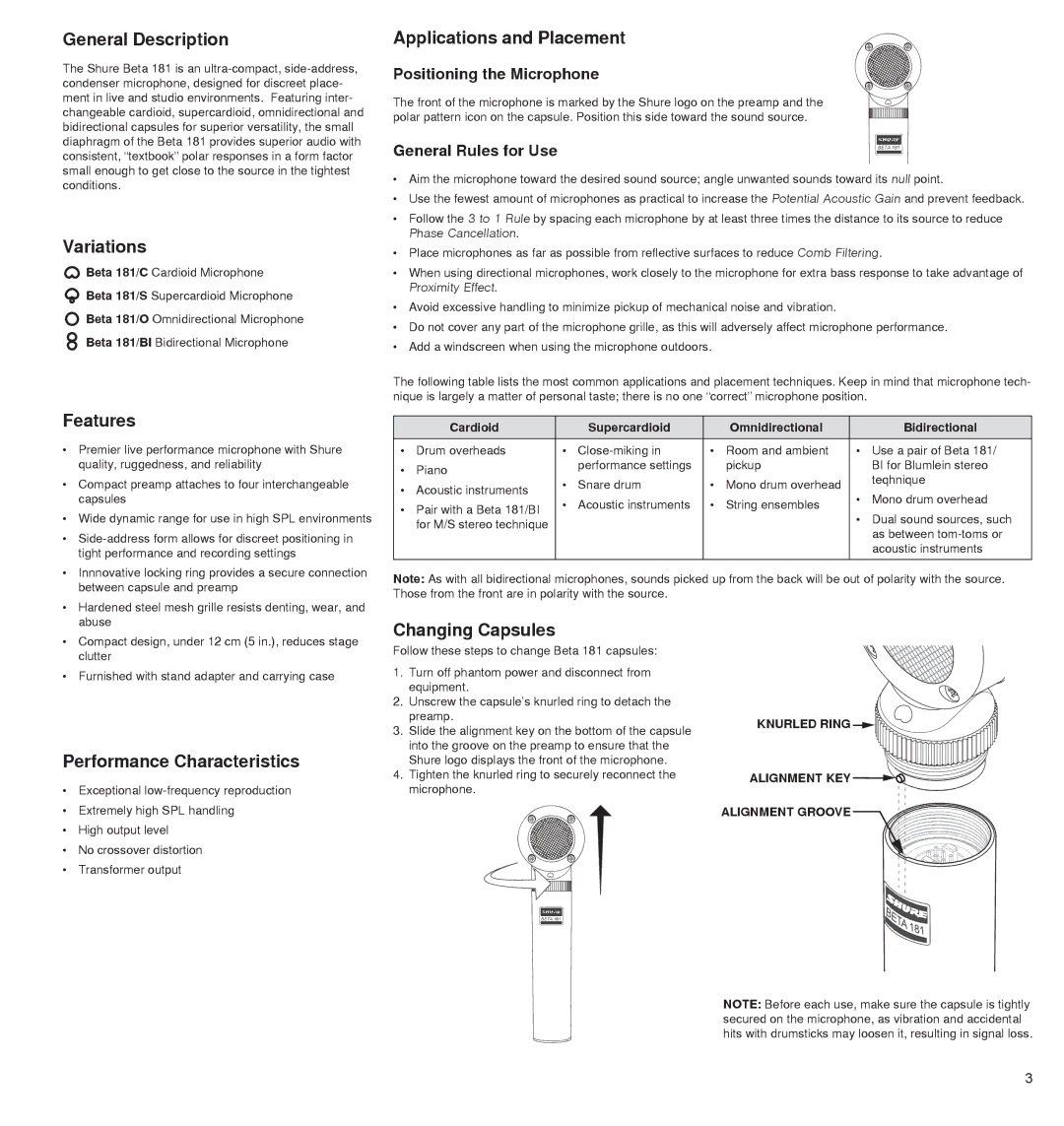
General Description
The Shure Beta 181 is an
Variations
![]() Beta 181/C Cardioid Microphone
Beta 181/C Cardioid Microphone
![]() Beta 181/S Supercardioid Microphone
Beta 181/S Supercardioid Microphone
![]() Beta 181/O Omnidirectional Microphone
Beta 181/O Omnidirectional Microphone
Beta 181/BI Bidirectional Microphone
Features
• Premier live performance microphone with Shure |
quality, ruggedness, and reliability |
• Compact preamp attaches to four interchangeable |
capsules |
• Wide dynamic range for use in high SPL environments |
• |
tight performance and recording settings |
• Innnovative locking ring provides a secure connection |
between capsule and preamp |
• Hardened steel mesh grille resists denting, wear, and |
Applications and Placement
Positioning the Microphone
The front of the microphone is marked by the Shure logo on the preamp and the polar pattern icon on the capsule. Position this side toward the sound source.
General Rules for Use | BETA 181 |
•Aim the microphone toward the desired sound source; angle unwanted sounds toward its null point.
•Use the fewest amount of microphones as practical to increase the Potential Acoustic Gain and prevent feedback.
•Follow the 3 to 1 Rule by spacing each microphone by at least three times the distance to its source to reduce
Phase Cancellation.
•Place microphones as far as possible from reflective surfaces to reduce Comb Filtering.
•When using directional microphones, work closely to the microphone for extra bass response to take advantage of
Proximity Effect.
•Avoid excessive handling to minimize pickup of mechanical noise and vibration.
•Do not cover any part of the microphone grille, as this will adversely affect microphone performance.
•Add a windscreen when using the microphone outdoors.
The following table lists the most common applications and placement techniques. Keep in mind that microphone tech- nique is largely a matter of personal taste; there is no one “correct” microphone position.
| Cardioid |
| Supercardioid |
| Omnidirectional |
| Bidirectional | |
• | Drum overheads | • | • | Room and ambient | • | Use a pair of Beta 181/ | ||
• | Piano |
| performance settings |
| pickup |
| BI for Blumlein stereo | |
• | Snare drum | • | Mono drum overhead |
| teqhnique | |||
• | Acoustic instruments |
| ||||||
• | Mono drum overhead | |||||||
• | Acoustic instruments | • | String ensembles | |||||
• Pair with a Beta 181/BI | ||||||||
• Dual sound sources, such | ||||||||
| for M/S stereo technique |
|
|
|
| |||
|
|
|
|
|
| as between | ||
|
|
|
|
|
|
| ||
|
|
|
|
|
|
| acoustic instruments | |
Note: As with all bidirectional microphones, sounds picked up from the back will be out of polarity with the source. Those from the front are in polarity with the source.
| abuse |
• | Compact design, under 12 cm (5 in.), reduces stage |
| clutter |
• | Furnished with stand adapter and carrying case |
Performance Characteristics
•Exceptional
•Extremely high SPL handling
•High output level
•No crossover distortion
•Transformer output
Changing Capsules
Follow these steps to change Beta 181 capsules:
1.Turn off phantom power and disconnect from equipment.
2.Unscrew the capsule’s knurled ring to detach the preamp.
3.Slide the alignment key on the bottom of the capsule into the groove on the preamp to ensure that the Shure logo displays the front of the microphone.
4.Tighten the knurled ring to securely reconnect the microphone.
KNURLED RING ![]()
![]()
ALIGNMENT KEY
ALIGNMENT GROOVE ![]()
BETA 181
NOTE: Before each use, make sure the capsule is tightly secured on the microphone, as vibration and accidental hits with drumsticks may loosen it, resulting in signal loss.
3
